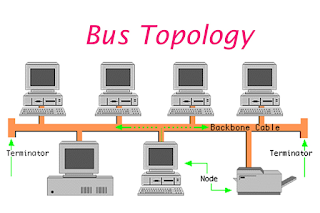WHAT ARE THE TYPES OF NETWORK TOPOLOGY?
Linear bus topology - uses long cable, referred to as a backbone, to which computers and other devices are attached. Easy installation, each cable needs to be connected with backbone cable, and Less Expensive/Less cables are required than Mesh and star topology. Not scalable as there is a limit of how many nodes you can connect with backbone cable. A terminator is a placed at each end of the backbone to keep the signals from bouncing back and being received again by the nodes (such as server, clients, printer, scanner, etc.) in the network.
Ring topology - is a type of network topology wherein nodes are connected to each other for ring one contiguous pathway in a ring formation. In other words, data need to travel from one node to the next, with each one receiving data traffic and passing it along to the next until it reaches its final destination. A ring network operates on the principle or single pathway. If a node fails, then the entire link gets disrupted.
Mesh topology - Originally conceived for military applications, mesh networks are structures wherein all the nodes on the network can route data traffic on their own. In mesh topology each device is connected to every other device on the network through a dedicated point-to-point link. When we say dedicated, it means that the link only carries data for the two connected devices only. (no data lost, reliable, recure, and Easy to troubleshoot).
Hybrid topology - As the name connotes, a hybrid topology is simply a network that uses a mix of any two or more different topologies in such a way that the final network does not exhibit one of the characteristics of the standard topologies. use a hybrid topology over a standard topology depends on the needs of a business, school, or the users.







Comments
Post a Comment